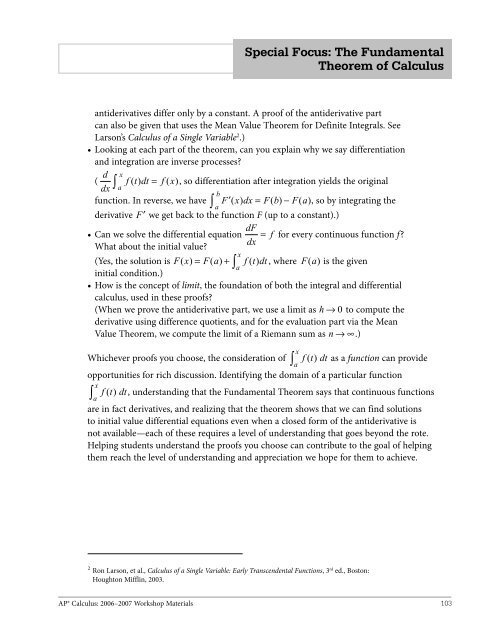AP Calculus
Create successful ePaper yourself
Turn your PDF publications into a flip-book with our unique Google optimized e-Paper software.
Special Focus: The Fundamental<br />
Theorem of <strong>Calculus</strong><br />
antiderivatives differ only by a constant. A proof of the antiderivative part<br />
can also be given that uses the Mean Value Theorem for Definite Integrals. See<br />
Larson’s <strong>Calculus</strong> of a Single Variable 2 .)<br />
• Looking at each part of the theorem, can you explain why we say differentiation<br />
and integration are inverse processes?<br />
∫<br />
x<br />
( d f ( t) dt = f ( x)<br />
, so differentiation after integration yields the original<br />
dx a<br />
b<br />
function. In reverse, we have ∫ F ′( x ) dx = F ( b ) − F ( a ), so by integrating the<br />
a<br />
derivative F ′ we get back to the function F (up to a constant).)<br />
• Can we solve the differential equation dF = f for every continuous function f?<br />
What about the initial value?<br />
dx<br />
x<br />
(Yes, the solution is F( x) = F( a) + ∫ f ( t)<br />
dt , where F( a) is the given<br />
a<br />
initial condition.)<br />
• How is the concept of limit, the foundation of both the integral and differential<br />
calculus, used in these proofs?<br />
(When we prove the antiderivative part, we use a limit as h → 0 to compute the<br />
derivative using difference quotients, and for the evaluation part via the Mean<br />
Value Theorem, we compute the limit of a Riemann sum as n → ∞.)<br />
Whichever proofs you choose, the consideration of ∫ f ( t)<br />
dt as a function can provide<br />
a<br />
opportunities for rich discussion. Identifying the domain of a particular function<br />
∫<br />
x<br />
a<br />
f ( t)<br />
dt, understanding that the Fundamental Theorem says that continuous functions<br />
are in fact derivatives, and realizing that the theorem shows that we can find solutions<br />
to initial value differential equations even when a closed form of the antiderivative is<br />
not available—each of these requires a level of understanding that goes beyond the rote.<br />
Helping students understand the proofs you choose can contribute to the goal of helping<br />
them reach the level of understanding and appreciation we hope for them to achieve.<br />
x<br />
2<br />
Ron Larson, et al., <strong>Calculus</strong> of a Single Variable: Early Transcendental Functions, 3 rd ed., Boston:<br />
Houghton Mifflin, 2003.<br />
<strong>AP</strong>® <strong>Calculus</strong>: 2006–2007 Workshop Materials 103


